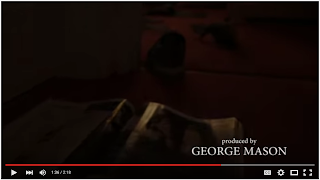Our Thriller Opening Sequence was based around a few key ideas. One of the main ones was the planting of mise-en-scene items throughout the set acting as little hints to the audience that all circum to sense once the dead body was revealed at the end. All these items that we featured are an obvious representation of age, gender, class, and regional identity.
For example, the stereotype of a teenage boy is messy, unreliable and lazy. This is clearly portrayed throughout the house in the way we messily dressed the set, leaving worn clothes, towels, shoes, food wrappers, dirty crockery and even cigarette buts in certain areas of the house. When these items are noticed, the idea of a stereotypical teenage male being the main inhabitant of the house is immediately implanted into the audience's brain sub-consciously, however it is not obvious why all these items are in the house until nearer the unveiling end.. As well as this, it is very typical of a family house to have family related objects. We displayed this using various items including mock-up family photos, a calendar, and even fridge magnet letters. This represents the stereotypical family home combined with the teenager living there.
When it came to the answer phone messages, which mainly contributed to the tension within our sequence, there are multiple examples of how different age, genders and regional identities are represented. For example, the teenage girlfriend is played by a teenage girl, and her script is very stereotypical of a needy and clingy girlfriend, which is common in relationships at this age. The mother is obviously older and very caring in that stereotypically motherly way. For example, she reminds him to keep the house tidy, what she's up to on holiday, and notifies him of the severity of the situation if he was to have a party, still in a typical high-pitched and squeaky 'mumsy' voice. As well as this, the father is the stereotypical laid-back parent while his wife frets about everything.All members of the family have strong accents that portray a lower-class-origin aspect to the family, with the dad having a strong Birmingham/Midlands accent, and the mum clearly originating from Essex. As well as this, the house itself represents an average working class house in the country, especially when you notice the dog flap and food bowl, and the standard utilities and accessories within the house.
We wanted to add a feel to the one-shot take we used in the sequence that placed the audience into the film as an investigative character. Using the handheld rig to shoot gave us a more shaky and human feel to the shot. This also emphasises the messiness (and maybe even intoxicated) of the stereotypical. As well as this, we varied the pace of the movement through the house so that when a mise-en-scene element was shown, we slowed down and focused on it in order to emphasise the importance of the object, while speeding up during the transitions between objects simplifies the general feeling of a journey through the house.
The editing in our sequence was a straight forward process due to the small number of shots (2) and little to worry about when it came to continuity. When adding the titles, we used a San Serif white font. This font was crisp and clean which juxtaposed the messy scene behind the titles. For us, the white represented purity and innocence of the house. Gradually, the scenes became worse and darker. As it builds in negativity, finally the dead body is revealed, and the final title, "Homecoming", appears in a dark red form of the font.
Unfortunately, I feel that the general representation of the classes, ages and genders have been too stereotypical and al most negative. In understanding of this, I would have preferred to have worked harder on crushing the stereotypes for each character, just in order to send a subliminal thought on the topic.
We wanted to add a feel to the one-shot take we used in the sequence that placed the audience into the film as an investigative character. Using the handheld rig to shoot gave us a more shaky and human feel to the shot. This also emphasises the messiness (and maybe even intoxicated) of the stereotypical. As well as this, we varied the pace of the movement through the house so that when a mise-en-scene element was shown, we slowed down and focused on it in order to emphasise the importance of the object, while speeding up during the transitions between objects simplifies the general feeling of a journey through the house.
The editing in our sequence was a straight forward process due to the small number of shots (2) and little to worry about when it came to continuity. When adding the titles, we used a San Serif white font. This font was crisp and clean which juxtaposed the messy scene behind the titles. For us, the white represented purity and innocence of the house. Gradually, the scenes became worse and darker. As it builds in negativity, finally the dead body is revealed, and the final title, "Homecoming", appears in a dark red form of the font.
Unfortunately, I feel that the general representation of the classes, ages and genders have been too stereotypical and al most negative. In understanding of this, I would have preferred to have worked harder on crushing the stereotypes for each character, just in order to send a subliminal thought on the topic.





No comments:
Post a Comment